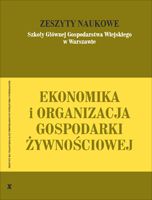Main Article Content
Article Details
BAŃSKI J. 2008: Ład przestrzenny obszarów wiejskich ze szczególnym uwzględnieniem oddziaływania gospodarki rolnej - ekspertyza przygotowana na zlecenie Instytutu Ekonomiki Rolnictwa i Gospodarki Żywnościowej - Państwowego Instytutu Badawczego, Warszawa, s. 6-7.
BARAN J., PIETRZAK M. 2007. Analiza efektywności wybranych branż polskiego agrobiznesu bazująca na metodzie DEA. Roczniki Naukowe Stowarzyszenia Ekonomistów Rolnictwa i Agrobiznesu, 9, 15-23.
BECKER A., BECKER J. 2009: Zastosowanie metody granicznej analizy danych do oceny gospodarowania województw Polski. [w:] Studia i materiały Polskiego Stowarzyszenia Zarządzania Wiedzą, (red.) J. Wątróbski, PSZW, Bydgoszcz, s. 1-12.
BRADLEY S., JOHNES J., LITTLE A. 2006: The measurement and determinants of efficiency and productivity in the FE sector in England. Lancaster University Management School Working Paper.
CRACOLICI M., NIJKAMP P. 2006: Competition among Tourist Destination. An Application of Data Envelopment Analysis to Italian Provinces. [in:] Tourism and Regional Development: New Pathways, (eds.) Giaoutzi M., Nijkamp P., Aldershot, UK.
DOMAGAŁA A. 2007: Przestrzenno-czasowa analiza efektywności jednostek decyzyjnych metodą Data Envelopment Analysis na przykładzie banków polskich. Badania Operacyjne i Decyzje, nr 3-4, s. 35-56.
GALANOPOULOS K., AGGELOPOULOS S., KAMENIDOU I. 2006: Assessing the effects of managerial and production practices on the efficiency of commercial pig farming. Agricultural Systems, vol. 88 (2-3), s. 125-141. (Crossref)
GUZIK B. 2009: Podstawowe modele DEA w badaniu efektywności gospodarczej i społecznej. Wyd. UE w Poznaniu, Poznań, s. 23-37.
JOHNES J. 2006: Data envelopment analysis and its application to the measurement of efficiency in higher education, Economics of Education Review, vol. 4, s.129-137.
JOO S., STOEBERL P., KWON I. 2007: Benchmarking efficiencies and strategies for resale operations of a charity organization. Benchmarking: An International Journal, vol. 14 (4), s. 455-464. (Crossref)
KISIELEWSKA M. 2005: Charakterystyka wybranych metod pomiaru efektywności bazujących na krzywych efektywności. Zeszyty Naukowe Akademii Ekonomicznej we Wrocławiu, s. 14.
LIS S. 1999: Vademecum produktywności. Agencja Wydawniczo-Poligraficzna "PLACET", Warszawa 1999. LEITNER K., PRIKOSZOVITS J., SCHAFFHAUSER-
LINZATTI M., STOWASSER R., WAGNER R. 2007: The impact of size and specialisation on universities' department performance: A DEA analysis applied to Austrian universities. Higher Education, Springer Netherlands, vol. 53, s. 517-538. (Crossref)
LOIKKANEN H., SUSILUOTO I. 2005: Cost efficiency of Finnish municipalities in basic service provision 1994-2002. Urban Public Economics Review, vol. 4, s. 39-64.
MARCZAK M. 2008: Skuteczność działań władz samorządowych Pomorza na rzecz rozwoju turystyki. Zeszyty Naukowe Instytutu Ekonomii i Zarządzania Politechniki Koszalińskiej, nr 2, część 1 Zarządzanie, s. 107-118.
MICHAILOV A., TOMOVA M., NENKOVA P. 2003: Cost efficiency in Bulgarian municipalities. Faculty of Finance and Accounting, University for the National and World Economy, Working Paper, Bulgaria, s. 39-45.
NAZARKO J., KOMUDA M., KUŹMICZ K., SZEBZDA E., URBAN J. 2008: Metoda DEA w badaniu efektywności instytucji sektora publicznego na przykładzie szkół wyższych. Badania Operacyjne i Decyzje, nr 4, s. 89-105.
PAWŁOWSKA M. 2003: Wpływ fuzji i przejęć na efektywność w sektorze banków komercyjnych w Polsce w latach 1997-2001. Bank i Kredyt, nr 2, s. 20-34.
PAWŁOWSKA M. 2005: Konkurencja i efektywność na polskim rynku bankowym na tle zmian strukturalnych i technologicznych. Materiały i Studia, Zeszyt NBP, 192, s. 20-25.
REICHMANN G. 2004: Measuring University Library Efficiency using Data Envelopment Analysis. Libri, vol. 54, s. 136-146. (Crossref)
ROGOWSKI G. 1998: Metody analizy i oceny banków na potrzeby zarządzania strategicznego. Wydawnictwo Wyższej Szkoły Bankowej, Poznań.
Rusielik, R. (2010). Zmiany efektywności działalności rolniczej w województwach polski po akcesji do Unii Europejskiej. Zeszyty Naukowe SGGW - Ekonomika i Organizacja Gospodarki Żywnościowej, (84), 13–21. (Crossref)
SZUWARZYŃSKI A. 2006: Metoda DEA pomiaru efektywności działalności dydaktycznej szkół wyższych. Nauka i Szkolnictwo Wyższe (półrocznik wydawany przez Centrum Badań Polityki Naukowej i Szkolnictwa Wyższego Uniwersytetu Warszawskiego), nr 2/28, s. 78-88.
SZYMAŃSKA E. 2009: Zastosowanie metody DEA do badania efektywności gospodarstw trzodowych. Journal of Agribusiness nad Rural Development, 2 (12), s. 249-255.
TUNA A., HILAR J.: 2008 Technical efficiency of peanut growing farms in Turkey. Acta Sci. Pol. - Oeconomia 7 (4), s. 5-15.





